Maintaining a saltwater pool is very similar to maintaining any other pool and they will serve you well if you maintain them properly. In this article, we will cover everything you need to know about what a saltwater pool is and how to maintain it so that you can keep your water looking great!
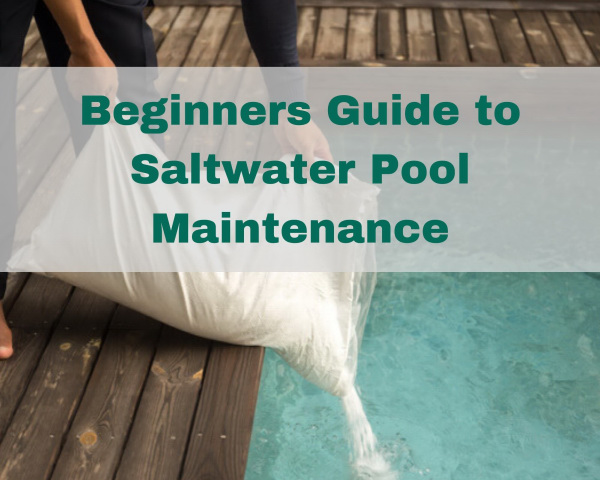
Article Contents
What is a Saltwater Pool?
Saltwater pools use a saltwater chlorine generator (SWCG) to produce chlorine through electrolysis for sanitizing the water. Other pools require you to add chlorine tabs or liquid chlorine to maintain your chlorine levels. In a salt pool, the SWCG converts the salt in your pool water to chlorine (electrolysis) which is then used to kill algae and harmful microorganisms.
How Do You Maintain a Saltwater Pool?
Maintaining a saltwater pool, or any other pool for that matter, can be broken down into four key areas and then further broken down based on how often each task needs to be performed:
- Keeping water balanced
- Proper water circulation and filtration
- Equipment maintenance
- General cleaning
Recommended Maintenance Schedule for Your Saltwater Pool
Weekly Saltwater Pool Maintenance
| Monday | Tuesday | Wednesday | Thursday | Friday |
| Test pH, Chlorine, alkalinity | (Fall and Spring) Empty and inspect/maintain skimmer and pump baskets. Empty robotic cleaner filter/bag. | (Summer) Test pH, Chlorine, alkalinity | Test pH, Chlorine, alkalinity | |
| Skim, brush, vacuum pool surfaces | (Fall) Skim, brush, vacuum pool surfaces | Skim, brush, vacuum pool surfaces | ||
| Empty and inspect/maintain skimmer and pump baskets. Empty robotic cleaner filter/bag. |
Monthly Saltwater Pool Maintenance
| Test and adjust Salt, Calcium Harness, Stabilizer (CYA) |
| Backwash Filter/Clean Cartridges (*Less frequently during off-peak pool season) |
| Inspect Salt Cell and Clean if needed |
| Inspect pool equipment and metal attachments |
As Needed Maintenance
| Take apart the DE Filter and clean with a hose once psi has reached +10 from starting psi after cleaning. |
| Replace sand in the sand filter (typically every 5 years). |
| Clean cartridge filters with diluted muriatic acid or filter cleaning solution |
| Clean salt cell with diluted muriatic acid. Do not clean unless calcium build-up is present as cleaning too often will decrease salt cell life. |
| Supplement SWCG with liquid chlorine if the temperature is too low for the system to generate chlorine. Consult the owner’s manual for specific details for your unit. |
Keeping Your Water Balanced
This is where you will be glad that you have a salt pool because one of the key benefits of having an SWCG is that you can very easily adjust your chlorine levels without having to physically add chlorine. However, chlorine is just one of many chemical parameters needed to keep your water balanced.
Start by Testing Your Water
Before you can adjust the water in your saltwater pool, you need to accurately test the water. To do this, you can use:
- Test strips
- A DPD drop testing kit (liquid test kit)
Test Strips
Test strips are quick and convenient. They’re not that accurate though. You may want to use this with a drop testing kit.
DPD Test Kit
A good quality DPD test kit is your best friend. These are the most accurate kits available. I must stress how important an accurate test kit is for your saltwater pool. Inaccurate water testing is the cause of many pool water issues.
Balance Weekly
Chlorine
Chlorine should be maintained at a level of 1-3 ppm. Refer to your SWCG owners manual for specifics, but in general, owners set their SWCG to 50% and adjust as needed depending on bather load and dilution or splash out. We recommend testing your chlorine level at least 2x/week.
*If your chlorine is very low and/or you are concerned about an algae outbreak then you can simply use liquid chlorine to immediately increase your chlorine level vs waiting on your SWCG to create the chlorine.
We have a full article on adding chlorine to saltwater pools here: Is it OK to Put Chlorine in a Saltwater Pool? (answered!)
Alkalinity
pH and alkalinity go hand in hand and have an interesting relationship. Alkalinity acts as a buffer or protector of pH and keeps it from bouncing up and down so it’s important to make sure that it is adjusted prior to adjusting pH.
Alkalinity can be lowered by using muriatic acid and raised by using plain baking soda or alkalinity up products.
pH
pH tends to rise faster in saltwater pools than in non-salt pools so it’s important to keep an eye on it. If it’s allowed to stay at 8.0 or over, then it can lead to scaling and staining. Chlorine is less effective if the pH is too high too. The ideal pH is 7.4 – 7.6.
pH can be lowered by adding muriatic or dry acid and it can be raised by using aeration or pH Up products.
Balance Monthly
Salt
You guessed it, this is a key for saltwater pools. Reference your owner’s manual for your specific SWCG, but typically you want to maintain a salt level between 3000 ppm-3300 ppm.
Calcium Hardness
If allowed to get too high, calcium hardness can cause scaling of your salt cell so it’s important to keep an eye on it if your fill water is hard. It can also damage other equipment such as pool heaters.
Stabilizer (CYA)
Think of a stabilizer as sunscreen for your chlorine. It’s important for salt pools because it will reduce the strain on your SWCG by protecting the chlorine from being destroyed by UV rays.
*It’s important to keep it below 70 as it can also inhibit your chlorine if it’s too high.
Proper Water Circulation and Filtration
For salt pools, it’s imperative to make sure that you run your pump long enough to generate enough chlorine. The typical run time is 8 to 12 hours per day during the summer and you can reduce it as the temperature drops.
Along with runtime, it’s also important for salt pool owners to make sure that they have their return jets pointed properly so that they distribute the chlorine to all parts of the pool and there is an even spread to prevent dead spots where algae could begin to grow.
The jets should make the water flow in a complete circle around the pool and not break the water’s surface.
Equipment Maintenance
Saltwater pools require the same periodic equipment maintenance as other pools, but they also require additional maintenance for the SWCG such as cleaning and special handling for winterization.
Clean Filter
Depending on the type of filter system you have, your filter needs to be cleaned anywhere from monthly to quarterly, or even more frequently during spring pollen season or high bather loads.
- Sand Filters – If you have a sand filter you can backwash to flush the contaminants out through the waste setting on your multiport valve. In some cases, you may need to change the sand, but that’s typically only needed every 5 years or so.
- DE Filters – Similar to sand, you can also backwash DE filters the same way but there is one difference. You will need to recharge your DE level because it is also flushed away as you backwash.
- Cartridge Filters – Cartridge filters can’t be backwashed so they will need to be taken apart and the cartridges sprayed with a hose to remove all the yucky stuff. If they are really dirty or oily they may need a more thorough cleaning with muriatic acid or filter cleaning solutions.
Clean Salt Cell
This is another unique maintenance item that will need to be done for saltwater pools. It’s important to check your cell for leaks and calcium buildup and clean it once or twice per season in a bucket of diluted muriatic solution made up of 4 parts water to 1 part acid.
You can also use a commercial salt cell cleaning product:
Related Reading: Ideal Pool Salt Options for a Saltwater Pool
Inspect Equipment
Visually inspect all equipment and attachments in the pool for signs of corrosion. In some cases, metal objects can react with the low salt content in the water and eventually corrode.
Installing a zinc sacrificial anode is a great way to protect metal items from being attacked in salt pools. It’s a rather complex topic, but the anode basically sacrifices itself and protects other metal objects from corroding.
Inspect Cleaning Equipment
Also be sure to inspect your pool cleaning equipment such as your pool pole and brush, net, robotic cleaners, and any other pumps or vacuum accessories you may use for corrosion or wear and tear.
Winterize SWCG
This is another maintenance item that’s specific to saltwater pools. Salt cells are vulnerable to being damaged during freezing weather so they must be removed and safely stored if deep freezing temperatures are expected and/or if you close your pool for the winter.
Start by turning off all power to pool equipment and unscrew the unions to remove the SWCG. You can replace it with a “dummy” cell to seal the pool lines where it was installed.
Next, inspect the cell and clean if needed. Dry thoroughly and store in a safe place until next season. If the cell needs to be replaced, buy a new one so you will have it ready to go when you need it.
General Cleaning
General cleaning for a saltwater pool is the same as any other pool as well. These are mostly weekly tasks, and sometimes need to be done multiple times per week depending on your location and the amount of debris that accumulates in your pool.
Empty Skimmer Baskets
This is a very important activity and shouldn’t be ignored, especially for pool owners who have a lot of trees near their pools, and it should be done every week at a minimum.
During the fall and winter, if baskets aren’t emptied then leaves can clog the skimmer basket and cause the pump to overheat because it has to work so hard to circulate the water. At the peak of the season, baskets may need to be emptied multiple times per day.
One trick for dealing with heavy leaf contamination is to use a cover on your pool to catch the leaves. You can also skim the surface of the pool to remove the floating leaves before they make their way into your skimmer basket.
Not only will keeping leaves out of your pool help your pump, but it will also help prevent staining by the leaves/acorns and will decrease the load on your SWCG. If left in your pool, leaves consume chlorine and will cause you to work your SWCG harder to keep up with the demand.
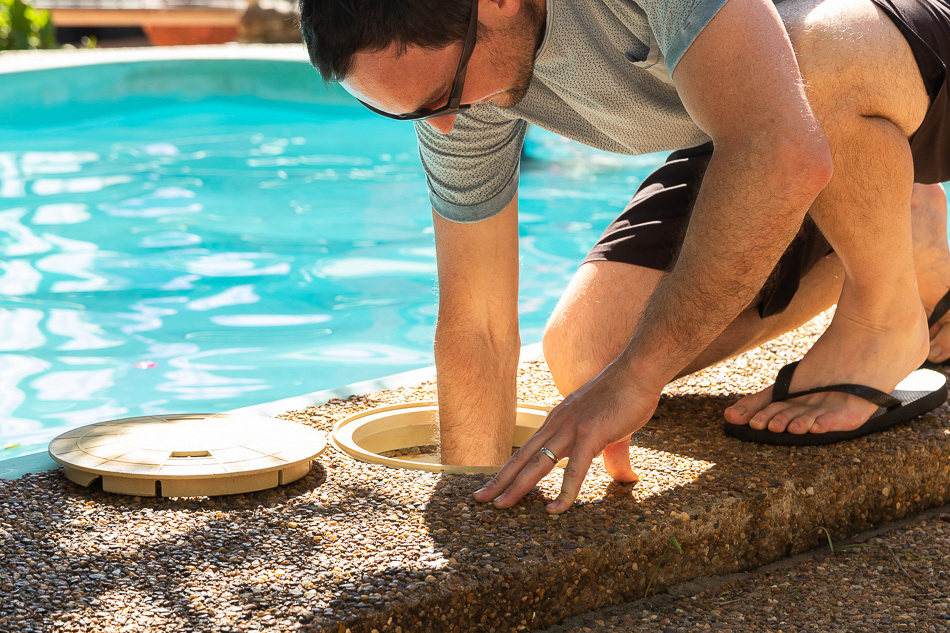
Empty Pump Basket(s)
For all the same reasons noted for skimmer basket cleaning, it’s also important to keep your pump baskets clean. This includes any pump that has a basket – your main filtration pump and any auxiliary water feature pumps as well.
Be sure to visually and physically inspect the basket for signs of cracking or wear that could damage your pump, filter, and valves. And when replacing the lid of the pump you also want to use pool grade silicone lubricant to coat the rubber gaskets in order to extend their life.
Vacuum Pool
All that debris and dirt that falls in your pool needs to be removed regularly. You can either vacuum your pool manually or use an automatic pool cleaner.
Vacuuming can be accomplished in several different ways and with several differentiated tools and methods.
Electric Robot Vacuum
A very popular method today is to use a robot vacuum. These are a bit pricey but they definitely make vacuuming easier and they do a great job of filtering the water as they vacuum too. Not only that, how cool is it to say that you have a robot cleaning your pool?
Robot vacuums use electricity so it’s important to remove them before swimming! You will also need to be sure to keep the robot’s filter basket emptied for all of the same reasons mentioned above about skimmer baskets.
Manual Hose Vacuum
These vacuums are the ones that connect to your filtration system through the skimmer typically and they use your pump suction to vacuum debris through the simmer and into the filter.
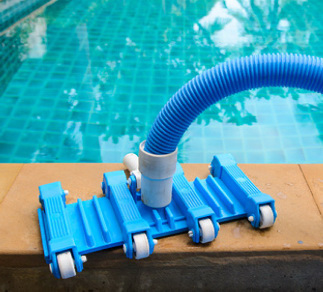
To use a hose vacuum, you should fill the hose with water first and submerge it and then attach one end of the hose to the opening in your skimmer. Then attach the other end to your vacuum attachment and roll the vacuum head back and forth along the floor.
Pressure Side Cleaner Robot
This type of vacuum is very popular and it requires a booster pump to work. It should be run daily on a schedule for at least 3 hours a day for best results.
You should make sure that there is nowhere for the vacuum to get wedged or stuck as it can damage the robot and the surface of your pool if left lodged and running. If you have a table or other feature that can cause that then you should trim the cleaner hose so that it can’t reach the obstacle.
The debris bag should be emptied at least once per week and more often if full before then.
Brush Pool
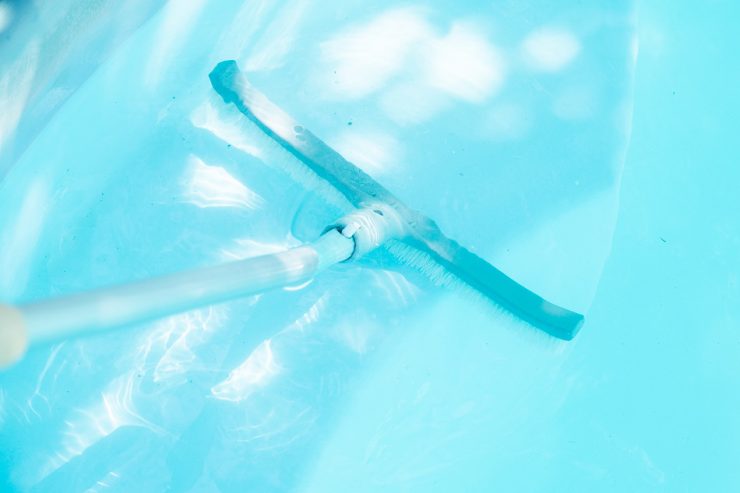
You should brush your pool at least once per week and even more frequently depending on the amount of debris that enters your pool. By brushing you free up any algae that may be starting to grow on the walls or floor and expose them to attack by your chlorine.
Brushing can also help keep your water clear by stirring small particles that can be filtered out. And remember those leaves? Brushing will prevent them from sitting in one place too long and staining your floor until you vacuum or scoop them up again.
The proper technique for brushing is to press the brush against the side of the pool wall and push it straight down to the floor. Once you reach the floor then pull the brush up and align it for the next stroke by overlapping the edge of where your last stroke was each time so that you don’t miss any spots.
When brushing the floor, be sure to get larger debris out first by vacuuming and then brush the floor towards your floor suction so that the dust and particles can be pulled into the drain for filtration. Overlap your passes just as you did with the walls.
Skim Surface and Floor with Net
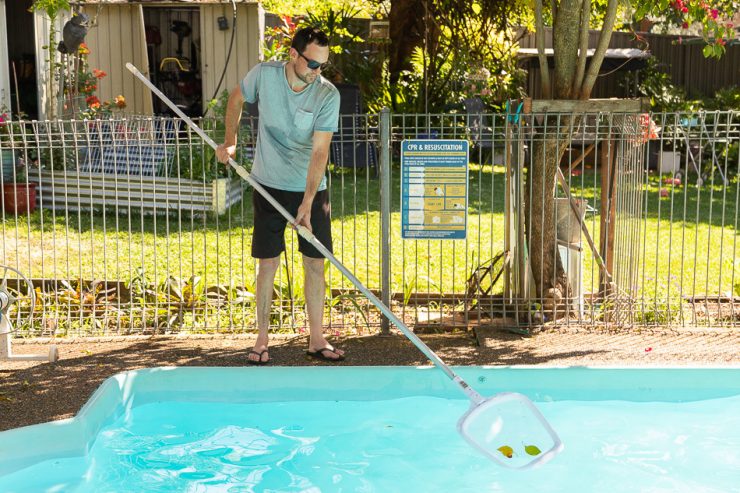
Removing larger debris like leaves, twigs, flowers, and several other non-friendlies with a skimmer net can make cleaning easier and extend the beauty and life of your pool.
Using a telescoping pole and net attachment, scoop large debris off the surface and the floor and dispose of it away from the pool so that it doesn’t just blow right back in again. Yep, I have done that too so take my advice and save yourself some hassle by using a small container to dump the debris in and put it in the trash.
Related Reading: Pool Filter Quickly Clogging Up (within days or hours)
Common Problems For New Saltpool Owners
As with all new things, it can take some time to get used to maintaining a saltwater pool. Here are some common problems and how to fix them.
1. Not Enough Chlorine
This could be due to several things and you should use the process of elimination to find the culprit.
- Not having the SWCG set high enough. Reference owners manual for recommended setting, but it’s typically 50%.
- Not running the pump long enough to allow the SWCG to create enough chlorine. Increase pump runtime.
- Low salt levels – Test salt and add if needed.
- Dirty saltwater cell – if the cell has a large amount of calcium buildup, this can decrease its efficiency. Clean it in a diluted muriatic acid solution to fix this.
- Low water temperatures – Cooler water prevents the SWCG from generating chlorine, and some systems even shut down at certain temperatures. Check the owner’s manual for water temperature operating ranges.
*If the temperature is too low and you aren’t closing the pool, simply add liquid chlorine until the water is warm enough again for the SWCG to function normally.
2. Constant High pH
pH will increase more rapidly in salt pools so it’s important to make sure that the alkalinity is within range to help control the pH. You can also add borate to the water to help buffer pH.
3. Salt Cell Needs Cleaning Frequently
This is caused by scale build-up and that’s usually a result of calcium being too high and depositing on the warm salt cell. Set your SWCG so that it turns off 10 minutes before the pump stops running to help minimize the scaling.
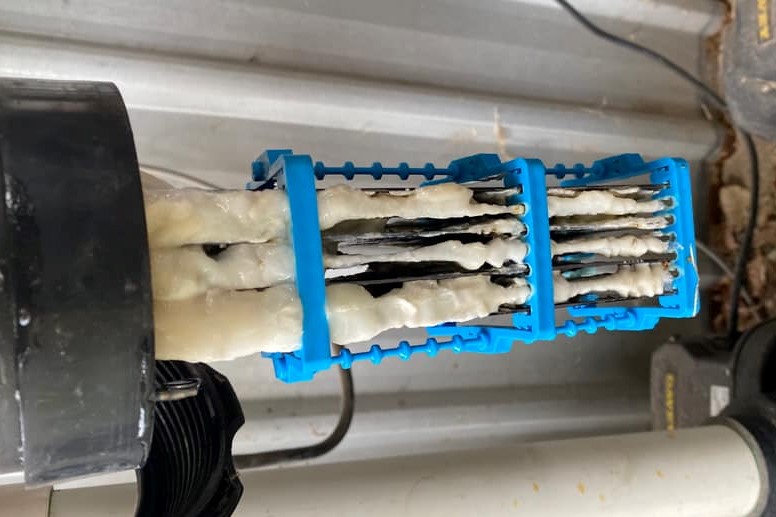
Related Reading:
Which Chlorine to Use for Inground Pools?
5 Alternatives To Using Chlorine For Pools








